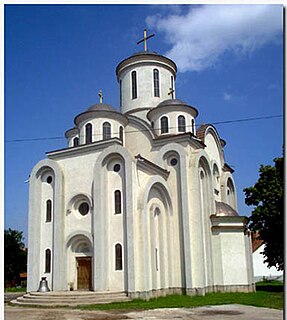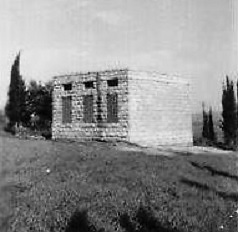
The Neolithic period is the final division of the Stone Age, with a wide-ranging set of developments that appear to have arisen independently in several parts of the world. It is first seen about 12,000 years ago when the first developments of farming appeared in the Epipalaeolithic Near East, and later in other parts of the world. The Neolithic lasted until the transitional period of the Chalcolithic from about 6,500 years ago, marked by the development of metallurgy, leading up to the Bronze Age and Iron Age.

The Vinča culture, also known as Turdaș culture or Turdaș–Vinča culture, was a Neolithic archaeological culture in Southeast Europe, in present-day Serbia, and smaller parts of Bulgaria, Kosovo, North Macedonia, Greece, Bosnia and Romania, dated to the period 5700–4500 BC or 5300–4700/4500 BC. Named for its type site, Vinča-Belo Brdo, a large tell settlement discovered by Serbian archaeologist Miloje Vasić in 1908, it represents the material remains of a prehistoric society mainly distinguished by its settlement pattern and ritual behaviour.

Lepenski Vir, located in Serbia, is an important archaeological site of the Mesolithic Iron Gates culture of the Balkans. The latest radiocarbon and AMS data suggests that the chronology of Lepenski Vir spans between 9500/7200–6000 BC. There is some disagreement about when the settlement and culture of Lepenski Vir began, but the latest data indicates that it was between 9500–7200 BC. The late Lepenski Vir architectural phase saw the development of unique trapezoidal buildings and monumental sculpture. The Lepenski Vir site consists of one large settlement with around ten satellite villages. Numerous piscine sculptures and peculiar architectural remains have been found at the site.

Dimini is a village near the city of Volos, in Thessaly, in Magnesia. It was the seat of the municipality of Aisonia. The name Aisonia dates back to ancient times and it is the westernmost place in the Volos area. The Dimini area contains both a Mycenean settlement and a Neolithic settlement. The Neolithic settlement in Dimini was discovered near the end of the 19th century and was first excavated by the archaeologists Christos Tsountas and Valerios Stais.

The Cucuteni–Trypillia culture, also known as the Tripolye culture, is a Neolithic–Eneolithic archaeological culture of Eastern Europe.

Lovas is a village and seat of municipality in the Vukovar-Syrmia County of eastern Croatia, located on the slopes of Fruška Gora, a few kilometers south of the main road connecting Vukovar with Ilok. Lovas has a population of 1,214 (2011), and its municipality also includes the smaller village of Opatovac which is located to the north, at the Danube. Lovas is underdeveloped municipality which is statistically classified as the First Category Area of Special State Concern by the Government of Croatia.
The Pfyn Culture is one of several archaeological cultures of the Neolithic period in Switzerland. It dates from c. 3900 BC to c. 3500 BC.

The Pengtoushan culture was a Neolithic culture located around the central Yangtze River region in northwestern Hunan province, China. It dates to around 7500–6100 BC, and was roughly contemporaneous with the Peiligang culture to the north. It is named after the type site at Pengtoushan.
Vinča-Belo Brdo is an archaeological site in Vinča, a suburb of Belgrade, Serbia. The tell of Belo Brdo is almost entirely made up of the remains of human settlement, and was occupied several times from the Early Neolithic through to the Middle Ages. The most substantial archaeological deposits are from the Neolithic-Eneolithic Vinča culture, of which Vinča-Belo Brdo is the type site.

The Hisar is a 341-metre-tall (1,119 ft) hill near the town of Leskovac in southern Serbia. A town's symbol, the hill is known for the remains of the large, fortified Bronze Age settlement and has been declared a nature park. The evidence confirm the almost continuous habitation from the Neolithic to the Ottoman period, and as the town of Leskovac engulfs the hill, until today.

Žitkovac is a village in central Serbia situated in the municipality of Aleksinac, in the Nišava District. Žitkovac has a population of 2,680 as recorded in the 2002 census.

Parța is a commune in Timiș County, Romania. It is composed of a single village, Parța, and was part of Șag commune until 2004.

Abu Zurayq is an archaeological site located on the western edge of the Jezreel Valley and its transition to the Menashe Heights, next to Highway 66, between the modern kibbutzim of HaZore'a and Mishmar HaEmek.

In the archaeology of Neolithic Europe, the burned house horizon is the geographical extent of the phenomenon of presumably intentionally burned settlements.

Midhowe Broch is an iron-age broch located on the west coast of the island of Rousay in the Orkney Islands, in Scotland.
Vukićevica is a village located in the municipality of Obrenovac, Belgrade, Serbia. As of 2011 census, it has a population of 584 inhabitants.

The Starčevo–Karanovo I-II–Körös culture or Starčevo–Körös–Criș culture is a grouping of two related Neolithic archaeological cultures in Southeastern Europe: the Starčevo culture and the Körös or Criș culture.
Tel Motza or Tel Moẓa is an archaeological site in Motza, on the outskirts of Jerusalem. It includes the remains of a large Neolithic settlement dated to around 8600–8200 BCE, and Iron Age Israelite settlement dating to around 1000 to 500 BCE and identified with the biblical Mozah mentioned in the Book of Joshua. In 2012, Israeli archaeologists announced the discovery of a temple from the Iron Age IIA levels at Motza, contemporary with the First Temple in Jerusalem.
Crkvine is a Neolithic locality and an archaeological site in the village of Stubline in the municipality of Obrenovac, which is part of the City of Belgrade, the capital of Serbia. The Neolithic settlement is dated to the 5th millennium BC and was part of the Vinča culture. The research of the site began in 1962 and the locality was declared a cultural monument in 2014.














